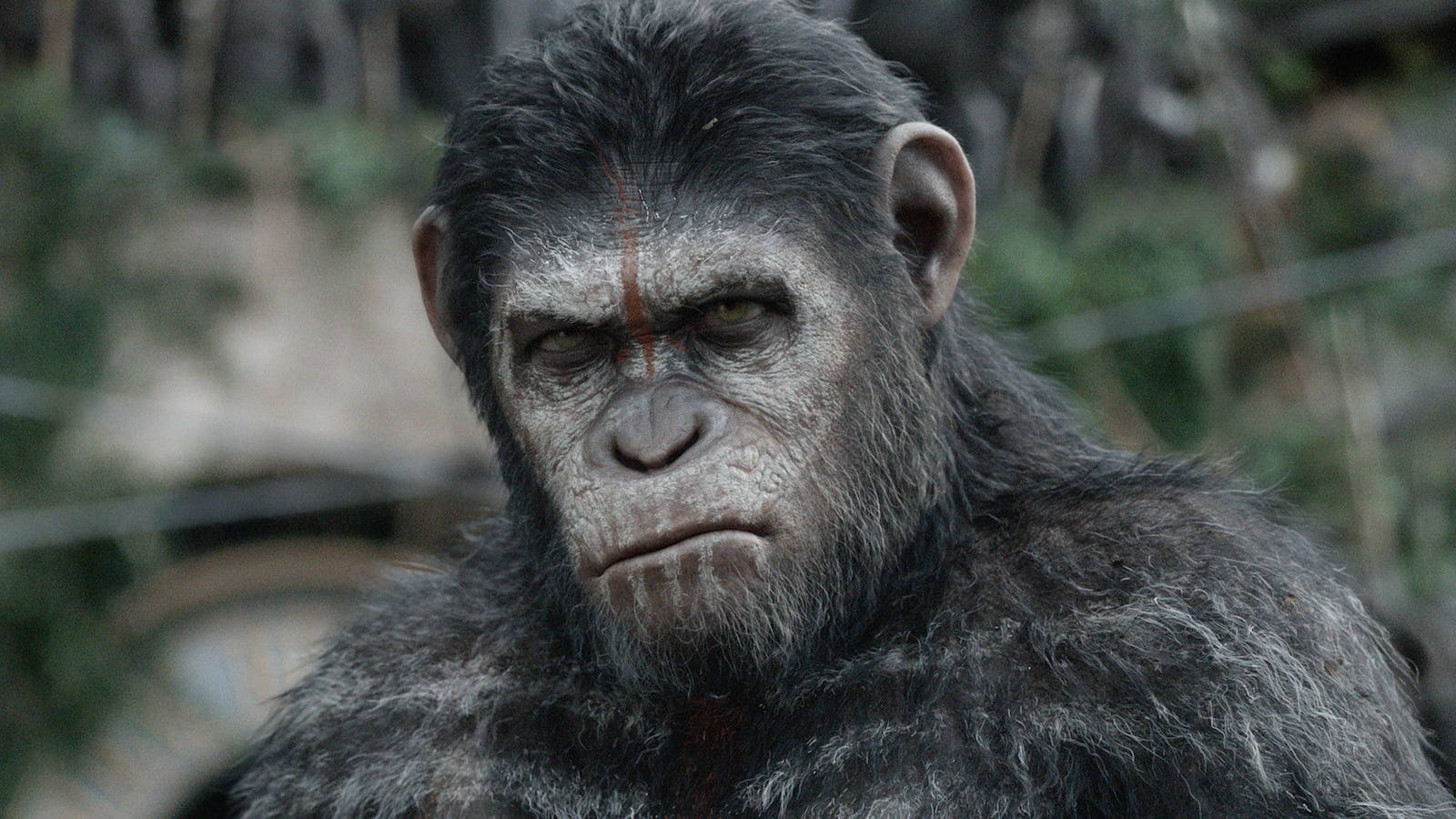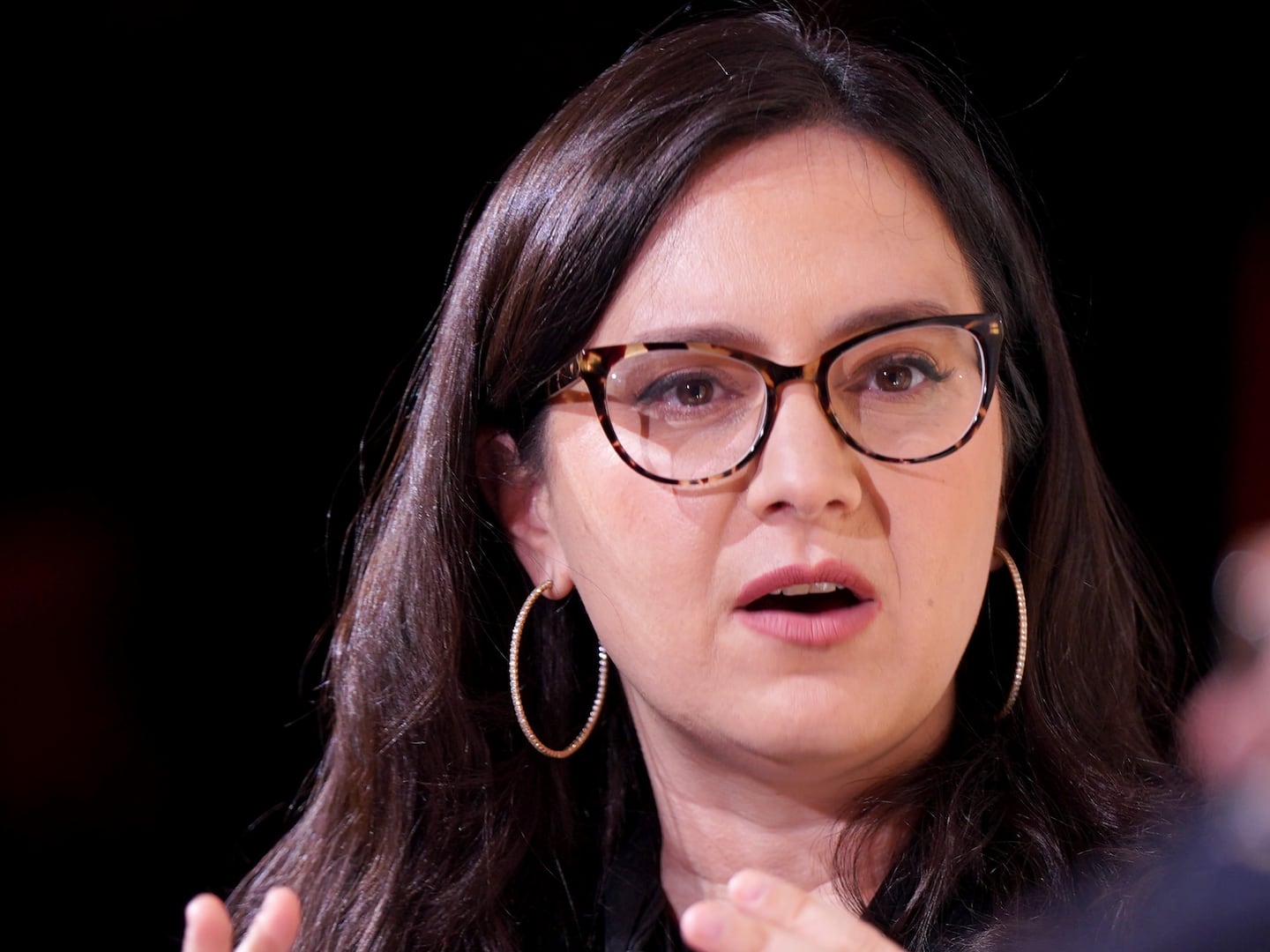He is, simply put, the Godfather of Motion Capture. After riveting turns as Gollum in the Lord of the Rings films, the eponymous ape in King Kong, Caesar in Rise of the Planet of the Apes, and Captain Haddock in The Adventures of Tintin, Andy Serkis has brought this burgeoning technology into the mainstream.

“I’m very pleased that motion capture technology has become standard,” says Serkis. “Every single nuance is now very closer to what I’m doing on set, which is very gratifying.”
Dawn of the Planet of the Apes seems like a watershed moment for motion capture. Directed by Matt Reeves (Cloverfield), it marks the first time that a mo-cap character—Serkis’ ape, Caesar—is the outright lead of a film, standing tall atop billboards and movie posters. In the film, set in a futuristic, plague-ravaged San Francisco, a small community of human survivors (led by Gary Oldman and Jason Clarke) has reached a détente with the apes, ruled by Caesar. But a series of misunderstandings triggers an all-out war between man and ape, threatening the future of mankind.
It’s an excellent film, and Serkis’ tender, humanistic turn has transformed Caesar into the most complex and compelling motion capture character to date.
How has the technology changed in capturing Caesar from Rise to Dawn?
This film is a much more epic film—in many ways Rise is domestic by comparison. A lot of it is outdoors and was shot in rainforests in Vancouver, and then they built this huge ape community set in New Orleans to represent San Francisco. Pretty much 99 percent of this movie was shot outside, so the technology has evolved to the point where you can shoot live performance-capture in outdoor locations. The crew had to put huge amounts of motion-capture cameras everywhere, which was a big challenge. The markers on the suits, unlike if you’re in a motion-capture volume, they’re reflective markers that send out a pulse because you’re dealing with daylight and film cameras. It’s gotten more robust, too. We pretty much destroyed all the cameras on Rise, so our head-mounted cameras are really rock-solid here.

Can you describe the “pulse,” and how that works?
If you’re in a motion-capture studio, you have spherical, reflective markers, which are picked up by cameras that emit infrared—it reflects it, and then the cameras pick up the data. These suits, because you’re outdoors and have sunlight and powerful film lights, the lights have to generate that light to be picked up by the cameras, so it’s the opposite way, really.
How has it been playing Caesar, this character who’s evolved from infancy to adulthood?
As far as the evolution of the character of Caesar, we’ve picked up the story 10 years later, and I’ve played Caesar from an infant, to a tough adolescence, to a revolutionary, to now a leader who’s galvanized this disparate group of apes and created this rather evolved society outside of San Francisco. He’s trying to incorporate tenets of belief that he’s learned from the humans—thou shall not kill, etc. And, as far as how the apes communicate with each other, we had these long improvisations before shooting started—about three weeks—with the characters, whether it’s chimpanzees, gorillas, orangutans, and we started out with vocalizations they’ve learned, and then worked on our own combination of gesture, vocalization, and American Sign Language, leading up to human language. As Caesar’s connection with humans increases throughout the movie, he begins to string together sentences that are philosophical and more thoughtful.
Do you view it as an anti-slavery allegory? Caesar is in many ways a Spartacus-like character.
I think it’s a commentary on many things and has a wider scope than enslavement. It has a lot to do with empathy and prejudice—the potential to avoid an escalating conflict through the ability to be empathetic. It talks about radicalization as well as fundamentalism—and the dangers of that. It’s also an anti-gun movie in many respects, and a movie for our times.
I picked up the anti-gun message, too. In the film, the humans have amassed a giant armory of weapons, which makes the apes very on-edge, and leads to them revolting.
That’s right. But even in the handful of humans that stumble into the ape territory, they use weapons out of fear, and the escalation really starts from that point. Instead of dealing with it in a different way, Carver’s [Kirk Acevedo] automatic instinct is to reach for a gun and shoot. Then, it goes into the breakdown of trust as a result, and the breakdown between the apes where Caesar wants to trust the humans, while Koba and the other apes don’t trust them because of their experience. This film is also about family and tribalism, and how far and absolute you are in your determination to uphold the principles and safety of your tribe versus another tribe. It’s the easiest knee-jerk reaction to want conflict, but what’s far more difficult is long-term, peaceful solutions.
Right. There are so many shootings these days, especially in the U.S., but for some reason people have failed to address any sort of long-term solutions to this epidemic, presumably because it is, like you said, far more difficult.
It really is. Matt Reeves didn’t want to make just a post-apocalyptic movie, but wanted to offer a moment in history that offered a glint of hope that it could be avoided. Ironically, the failure of Caesar to isolate that there are good and bad in apes and humans equally is his fatal flaw as a leader. He overlooks the fact that there’s good and bad in both sides, and that’s something that he has to confront.
What are the biggest hurdles, for you, in doing a motion capture performance versus a live-action one? It does seem like a mo-cap performance takes a greater suspension of disbelief on the part of the actor, since you’re in a gray suit covered in sensors.
The fact of the matter is I have done so many parts. Even going back as far as the playing of Gollum on set, I never considered it any different than if I was playing him in a loincloth and prosthetic makeup; I wouldn’t have approached the character any differently. That’s the thing that needs to be understood: Performance capture is just a technology that picks up everything you’re doing, but in terms of embodying the role physically, mentally, and doing all the research, you do that with any character you play as an actor. We are creatures of imagination and trick ourselves into believing we’re murderers, lovers, etc., so what you wear is just a superficial coating. I’ve never drawn a distinction between doing a motion-capture performance and one without motion-capture technology, because it’s just a different set of cameras.
To give an example, when you’re working on one of these roles and start building the character, you’re also able to look at that character in a rudimentary form on the motion-capture stage. You can look into what is in effect a magic mirror and see your avatar onscreen, and then calibrate your movements to a version of Caesar, so I can see Caesar onscreen and me moving around. That’s like having your first costume fitting, really, where you go, “Well, I like this pair of shoes because it makes the character feel important.” You do that to a certain extent with performance capture by the way you calibrate the model of Caesar—or the rig, as we call it. I can be hunched over, or push my chest out more and give Caesar strength and physicality. I can play that out in the rehearsal room, or motion-capture volume, and then my muscle memory encodes that so I don’t have to worry about it when I go on set.
At the same time, playing an animal does require more feral-ness, so to speak. Do you consider yourself “one with the animals?” Maybe…visit a lot of zoos as a child? [Laughs]
[Laughs] I do love nature but I don’t suppose I’d spent more time in zoos as a child than anyone else! But I always look for the inner animal in any character I’m playing, and how they carry themselves physically, and how the character is attached to its most basic, animalistic emotions. Certainly as a child, I’ve always loved transformation. The art of transformation is a very important thing to me, and I always believe I can say something more truthful through characters that are further away from me.
There was an awards push for Rise where many wanted you to be nominated for Best Supporting Actor for Caesar. Do you think it’ll take awards recognition for motion capture to be fully accepted as an art form?
It would be important. There have been some great acting performances that weren’t onscreen this year. I thought Scarlett Johansson’s performance in Her was magnificent; just a brilliant performance, and equally as emotionally resonant as the one Joaquin Phoenix gave. Cinema has moved into different times where we can play characters using all sorts of different technologies, but we also want to see stories where humans are not just humans onscreen. Human performances and the emotion of a character doesn’t just mean seeing a human performance onscreen and a live actor’s face onscreen. There’s been a philosophical shift and people have to get onboard. Younger actors who’ve come out of drama schools just accept that performance capture is another form of acting. There are a few remaining skeptics who just can’t see it, so there’s a certain amount of education that needs to happen.
You’re listed as a performance capture consultant on Avengers: Age of Ultron, and have been helping Mark Ruffalo to capture the Hulk. What have you been teaching him?
The difference for Mark this time around is that the Imaginarium, which is our performance-capture studio in London that’s providing all the performance capture for the Avengers movie, is providing education. Previously, he would’ve walked onto a set and you’ve got Thor and all the other characters in their costumes looking magnificent, and then you’d have Mark in a grey motion-capture suit playing this enormous character, so it’s about giving the actor the right atmosphere and credibility for the performance, which we did in a number of ways. We had to educate the director that the actor owns the role, and what you get on the set is what you should be aiming to put into your cut as the final performance—with the rendering coming later on.
Also, we worked with Mark in really grounding him and playing with the digital avatar before going on set so he could see himself as the Hulk before going onscreen, and we put weights and inhibitors on him to give him the sense that his arms were these big, giant wrecking balls, and so that his biceps wouldn’t intersect with his body. We equipped him. We also gave him a sound system and pitch-modulated his voice so you could hear the enormous Hulk roar coming out of these speakers, so the crew would go, “Jesus! That’s Hulk on set!” It gives Mark the sense of feeling better, and if he feels better, then he’ll be more comfortable in the performance.
You’re also apparently playing a character in Avengers: Age of Ultron…is it Thanos?
Um…I’d have to deny that character at this point. But I am playing a character. I was really thrilled that Joss Whedon asked me to be involved. It’s fantastic. I’ve had a ball working with them, both as performance capture consultant through the Imaginarium, but also being asked to be in it. But I can’t say anything more!
As far as Star Wars: Episode VII goes, I know you’re sworn to secrecy, but can you at least confirm that you’re NOT playing a Jar Jar Binks-like character? [Laughs]
[Laughs] I am definitely NOT playing anything like Jar Jar Binks! That I can confirm.
You’d also been setting up a motion-capture film version of the Orwell novel Animal Farm. Is that project still happening? Yes, absolutely. We’ve been evolving that scripturally and the methodology for that conceptually has been happening over the course of the past year, but we’ve moved it back because I’m not directing Jungle Book for Warner Brothers.
Why is there always two of the same movie out at the same time in Hollywood? There’s your Jungle Book, and also Jon Favreau’s.
You know, in this case, they couldn’t really be further apart. I believe Jon Favreau’s Jungle Book is very much honoring the 1968 Disney version, and our one is much closer to Rudyard Kipling—it’s a darker teenage coming-of-age story. There’s absolutely room for two movies in this case.
Lastly, where do you see motion capture heading? It’s come so far already, to the point where a mo-cap character is top-lining a summer blockbuster.
Absolutely. That’s why I wanted to set up the Imaginarium. I think it’s still in its infancy. At the moment, it’s only been used to play humanoid-type characters, but with Jungle Book and Animal Farm, we’re looking at creating difficult, complex creatures. We’re also looking at different solutions for real-time facial pipelines, because once real-time facial is possible, you can do rapid motion-capture turnarounds for TV, and the rendering becomes a lot cheaper. It will move into television. Also, there’s the live-theatrical applications as well, where you can marker-up ballet dances, contemporary dances, or project real-time avatars onscreen at rock festivals. There are a lot of places it can go, and there can be many more abstract characters, sounds, and more. The possibilities are endless.






